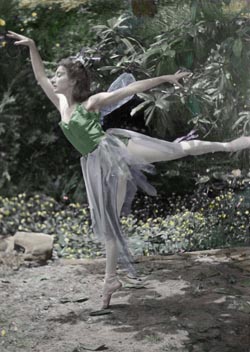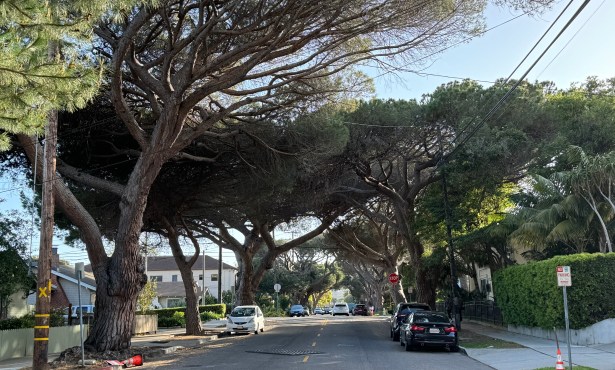Ernestina Charlotte Franceschi Fenzi 1918-2007
Ernestina Fenzi was an extraordinary individual from an extraordinary Santa Barbara family. Her grandfather, known in this country as Dr. Francesco Franceschi, arrived in 1893 to found the Southern California Acclimatizing Association with Charles Frederick Eaton in Montecito. Born Emanuele Orazio Fenzi in Florence, Italy, he moved to Los Angeles in 1891 and changed his name when the family bank failed. Franceschi not only introduced more plants to the Santa Barbara region than any other person, he was also an important writer, an internationally significant horticulturist, and an innovator in horticultural practices, such as sustainability. A portion of Montarioso, where he lived with his wife, Cristina, and three of their six children, became Franceschi Park in 1931. His name reverted to Fenzi when he returned to Italy briefly in 1913 before moving to colonial Libya in North Africa, so his family members in Santa Barbara were sometimes called the Franceschi Fenzis.

Ernestina was fiercely proud of her family’s aristocratic lineage and many accomplishments. These accomplishments extended to Franceschi’s children and grandchildren, including Ernestina herself, who pursued a career as a ballerina and choreographer in Europe and the United States, owned two ballet schools in Italy, and founded the California International Theatre Exchange Ballet Center in Santa Barbara in 1968. She was a cultural force when this city was a small town, mounting ballets of her own design here and in Los Angeles and arranging opportunities for her students to interact with distinguished dancers. Ernestina was named after her aunt, Dr. Franceschi’s eldest daughter and assistant horticulturist. Like her namesake, Ernestina loved plants and never married.
Ernestina’s father, Franco Franceschi Fenzi, was the youngest of the Franceschis’ children. A petroleum engineer, he married Marguerite Dibble. Ernestina was born in Santa Barbara after her grandparents departed. She had bright red hair and a sunny disposition. Her dance instruction began early in the popular modern style and then in ballet, which she took with the first Mme. Maria Kedrina. When Ernestina was 11, her family moved to Florence, Italy, where her lessons continued. By age 15, she was dancing in a noted Florentine opera company’s corps de ballet. She was in the cast of Ballerine, a 1936 movie directed by Gustav Machat½, and studied for three years with the famous Olga Preobrajenska in Paris.
Ernestina was in England when World War II broke out, making it impossible to return to Italy. As a member of Lydia Kyasht’s London company, Ballet de la jeunesse Anglaise, she toured throughout Great Britain. A highlight of this London period was being one of Cecil Beaton’s costuming models for the 1946 film Carnival, a melodrama with Michael Wilding.
After the war, Ernestina opened a ballet school in Palermo, Italy, choreographed dances presented at Teatro Biondo, and performed with ballet companies as a guest artist. When the city was severely damaged by an earthquake, the school was forced to close. She returned to Santa Barbara to live with family and founded the California International Theatre Exchange Ballet Center in the Lobero Theatre’s rehearsal hall. (Subsequently relocated to a studio by the Riviera Theatre, its name was occasionally shortened to Theatre Ballet Center or Fenzi Ballet.) Ernestina was artistic director, choreographer, and instructor. Her goal was an enhanced artistic environment for the benefit of all. She would prepare students to continue their training abroad, and would bring some of her former colleagues and students in Italy to California.
Finances made this difficult for the small Theatre Ballet Center, so exchanges mainly took place with troupes in Los Angeles with which Ernestina had been associated (sometimes as a dancer or choreographer), including David Lichine’s, Irina Kosmovska’s, the American Concert Ballet company, and the Brown Gables company directed by Yvonne Mounsey (now the Westside School of Ballet.) Miss Fenzi, as she was always called, gave her students a classic, technical grounding and took pleasure in their many successes. One of the students whom Ernestina inspired to teach was Ellen Schipper, today the director of the West Coast Ballet Company and the Ellen Schipper Classical Ballet Studio.
Ernestina closed her Santa Barbara school in the late 1970s and opened one in Volterra, Italy, which continues to this day. She returned to Santa Barbara when she retired.
Ernestina spoke English with a Tuscan accent, enjoyed conversing in Italian with her old friend Father Virgil Cordero, loved to paint and teach children to dance, had an upbeat personality (although she could be a bit of a diva), never learned to drive, and was passionate about preserving her grandfather’s legacy, including Franceschi House.
Originally trained in classical ballet techniques by Russians who had fled the revolution there, Ernestina was also adept in more contemporary styles, partnering in Coppelia with Gene Marinaccio and choreographing Yorinda and Yoringel for an evening of contemporary music presented at Lotte Lehmann Concert Hall in 1972. A review of her 1971 production of Peter and the Wolf summarizes her skills: “Ernestina Fenzi’s presentation of that Prokofiev classic (her own choreography) on the Riviera campus last week was a delight. It had charm, originality, good technique, and a ‘sense of comedy,’ and it was not bogged down in ballet routine for ballet’s sake. Each character moved according to its own characteristics, with precision and good theater.”
Laura Salvi Morrison, who teaches Italian, first met Ernestina when both showed up at a City Council meeting to support saving Franceschi House from demolition. It turned out that Dr. Franceschi had been associated at the Botanical Gardens in Florence with Laura’s great-grandfather Federico Delpino. Laura introduced me to Ernestina in the hope that she would provide information for a two-part article I was writing on Dr. Franceschi for Pacific Horticulture magazine.
Ernestina agreed to meet me for coffee at an Italian restaurant. Laura dropped her off and left us to get acquainted. While we were waiting for our espressos, Ernestina told me she was writing a book about her famous grandfather, and she did not want to give me any material until it was finished. The coffee was set before her, she took a sip, and began to shout, “It’s water!” We beat a hasty retreat-Ernestina laughing the whole way-to another place that met with her approval. She found the entire adventure highly amusing, and invited me to her apartment to see some of her family photographs.
Regretfully, Ernestina never finished her book. Her niece, Joan Fenzi, recently shared boxes of clippings and family albums that Ernestina had carefully compiled. Her impish sense of humor is there in photos of her as a girl and as a ballerina-airborne in so many of the pictures.



